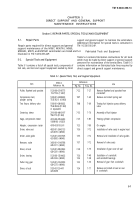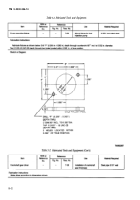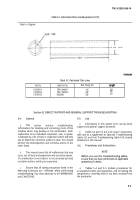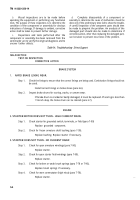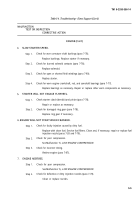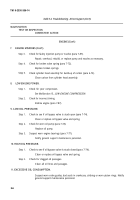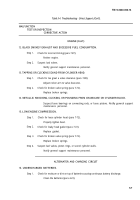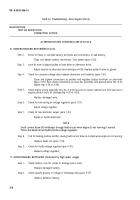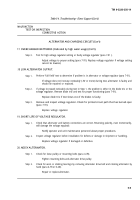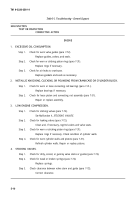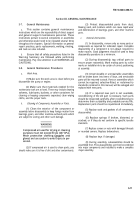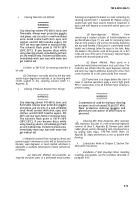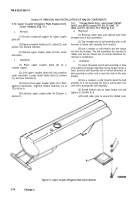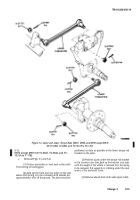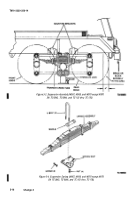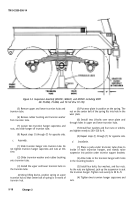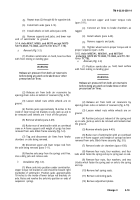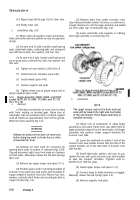TM-9-2330-356-14
SEMITRAILER, TANK: 5000 GALLON, BULK HAUL, SELF LOAD/UNLOAD M967 AND M967A1; SEMITRAILER, TANK: 5000 GALLON, FUEL DISPENSING, AUTOMOTIVE M969 AND M969A1; SEMITRAILER, TANK: 5000 GALLON, FUEL DISPENSING, UNDER/OVERWING AIRCRAFT M970 AND M970A1
TECHNICAL MANUAL; OPERATOR’S, UNIT, DIRECT SUPPORT, AND GENERAL SUPPORT MAINTENANCE MANUAL
OCTOBER 1990
TM-9-2330-356-14 - Page 319 of 528
TM 9-2330-356-14
Section III. GENERAL MAINTENANCE
5-7.
General Maintenance
a.
This section contains general maintenance
instructions which are the responsibility of direct support
and general support maintenance personnel. These
instructions pertain to several components or assemblies
and otherwise would need to be repeated several times
throughout the chapters. Special information on general
repair practices, parts replacements, welding, riveting,
and tools are also included.
b.
Ensure that all safety precautions listed in the
Warning Summary are followed while performing
maintenance. Pay close attention to all WARNINGS and
CAUTIONS.
5-8.
General Maintenance Procedures
a.
Work Area.
(1) Make sure the work area is clean before you
disassemble the pump or engine.
(2) Make sure that materials needed for the
maintenance task are at hand. These may include cleaning
solvents, lubricants, buckets, or other containers for
cleaning or keeping components separated, clean wiping
cloths, and the proper tools.
b.
Cleaning of Components, Assemblies or Parts.
(1) Clean the exterior of the component or
assembly before disassembly to keep foreign matter from
bearings, gears, and other machine-surfaced parts which
are subject to scoring and other such damage.
WARNING
Compressed air used for drying or cleaning
purposes must not exceed 30 psi (207 kPa).
Wear protective clothing (goggles and
gloves) and use caution to avoid Injury to per-
sonnel.
(2) If compressed air is used to clean parts, you
should make sure it is free of dirt and other contaminants.
(3) Protect disassembled parts from dust,
blowing sand, and moisture which can cause rapid wear
and deterioration of bearings, gears, and other machine
parts.
c.
General Instructions.
(1) In disassembly, remove only as many parts or
components as required for indicated repair. Complete
disassembly of a component is not always required to
make repairs. Good judgement should be used to keep
disassembly operations to a minimum.
(2) During disassembly, tag critical parts to
ensure proper reassembly. Mark mating parts by scribe
marks or indelible ink to be certain of correct positioning
at assembly.
(3) Unserviceable or unrepairable assemblies
will be broken down into items of issue, and serviceable
parts will be returned to stock. Parts or assemblies which
cannot be repaired, selective-fitted, or reclaimed to
standards contained in this manual, will be salvaged and
replaced with new parts.
(4) If a required new part is not available,
reconditioning of the old part is necessary. Such parts
should be inspected carefully after reconditioning to
determine their suitability and probable service life.
Replacement parts should be requisitioned immediately.
(5) Replace seals and gaskets of all components
disassembled.
(6) Replace springs if broken, distorted, or
cracked, or if they do not conform to specific tensile
standards.
(7) Replace screws or nuts with damaged threads
or rounded comers. Replace lockwashers.
(8) Replace keys if damaged.
(9) During assembly, subassemblies should be
assembled first. The subassemblies can then be combined
into major components and installed to make a complete
major assembly.
5-11
Back to Top

